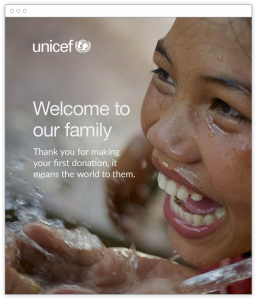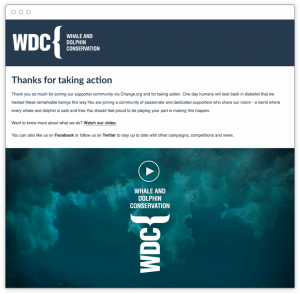How to set up an automated welcome email series for your nonprofit organization
Automated welcome emails can benefit your nonprofit in many ways. Let’s start with the most basic: building a relationship with your supporters.
Just like in real life, you can’t just ask someone to donate or volunteer the first time you meet them. You have to build some kind of relationship first — or at least introduce yourself — before anything else.
Sending an automated welcome email series is the best way to introduce your nonprofit to your new donors and constituents. It offers you the chance to build a relationship with them and familiarize them with your organization not just once, but through several emails.
Before we discuss how your organization can use automated welcome emails, let’s first take a look at why you should use email marketing.
Email marketing is one great way to connect with your supporters.
There’s no denying the power of email as a communication medium. It delivers 3 times the value than social media. In addition to this, more than 269 billion email messages are sent every day.
You can utilize email marketing to expand your reach, grow your donor base (the right way) and drive donations.
But considering that nonprofits sometimes lack the time and manpower, is it possible to keep your audience engaged while you juggle several other tasks? The answer: it’s possible.
Enter email automation.
Automating your emails can help you do just that, plus save you time and money in the process. One good example of this — and also one of the easiest to automate — is the welcome email.
True to its name, your welcome email should welcome your new subscribers. Thus it should be sent immediately after a new subscriber signs up.
Welcome emails are incredibly effective.
In fact, they see more than 3x the transactions and revenue per email over regular promotional mailings. Welcome emails also have an average open rate of 58%, which is more than most marketing messages.
Use a welcome email to introduce your subscribers to what your nonprofit does and how they can get involved.

However, sending a single email isn’t enough to set the stage.
That’s why you need to send a welcome email series.
A welcome email series lets you go beyond the welcoming part by familiarizing people with your organization through several automated emails.
It allows you to connect more often, create trust and build a stronger relationship with your subscribers. This eventually leads to deeper engagement, which can result in better involvement with your organization.
Open rates of welcome email series can average over 50%, while those with a call-to-action receive a click-through rate of nearly 15%. These numbers show how effective welcome email series is.
Let’s take a look at why you should send a welcome email series.
- To enhance opportunities. Not all subscribers are engaged right from the start. Their engagement level may differ from one another. Sending a welcome email series gives you more opportunities to connect and engage with your subscribers through several automated emails.
- To increase interactions. A welcome email series offers more interactions with your supporters than a single welcome email. It gives you the opportunity to know your subscribers better. For instance, you’d know if they find the resource you sent them helpful or not. They can also ask you questions, thus opening more avenues of interaction.
- To encourage action. A welcome email series can tell the audience more about your organization, advocacy, and work. What’s better is that you can include an incentive in your emails, such as a free resource, a discount, or a gift, to encourage action.

An automated welcome series needs to be done right especially since it’s the first phase of establishing a relationship with your subscribers.
Here are four steps to create an automated welcome email series for your nonprofit:
4 steps to create an automated welcome email series for your nonprofit #NPMC Share on X1. Determine your goals and key messaging.
Start with setting up goals for your welcome email series — with the primary goal of introducing them to your organization. Craft the essential things you need to say, such as:
- Your history, vision mission and goals
- Stories of impact you’ve made
- Past successes
- Exclusive perks for subscribers
- Your events calendar
You can also take your welcome email as an opportunity to make new subscribers more engaged and eager to participate.
- Invite them to follow your organization on social media.
- Tell them about your blog and give an option to subscribe.
- Invite them to volunteer or upgrade their donation habits.
It’s important to speak to your subscribers where they’re at. Since they’re new to your organization, you’ll want to get them on board and inspire them to adopt your mission.
Also, provide a clear action in your message. A test by Unbounce found that a single, strong call-to-action in an email increases clicks by 371%. So better cut the clutter and make the next step clear.

2. Create a structure and set the pacing.
After setting your goals and outlining the messages you’ll send, it’s time to create a framework and decide on cadence.
The sequence of your email delivery is crucial.
To elaborate, you would naturally send a personal introduction — with your organization’s story, history, etc. — to your subscribers first before asking them to make additional commitments.
The rest of your emails’ sequence will depend on what actions you want subscribers to take. A good rule of thumb? Start with a call-to-action with the least resistance.

Next up: Set the pace of your emails.
How often you send your emails is up to you, with the exception of the first email which should be sent immediately. Doing so helps you stay relevant and top-of-mind among your new supporters.
When deciding on an email frequency, consider if you’ll add your new subscribers to your regular list or keep them off, mainly because:
-
- They might not be ready yet for the campaigns or promotions in your regular emails.
- The number of emails they will receive from you might be overwhelming.
- If you choose not to add them on your regular list, you need to keep them engaged with your welcome email series.
A good tip: Space out your welcome emails that won’t overwhelm your new subscribers.
Craft the message and design of your email.
The overall look and feel of your email reflect your organization’s brand. The design, imagery, style, and tone you use matter in communicating your message.
Putting a lot of thought into your overall email design is another important aspect. Below is a checklist of things to do in creating and designing your email.
- Use a clear template. Keep your layout looking sleek, uncluttered and professional so you can present your message in a reader-friendly way. Be sure your template is consistent in your welcome emails.
- Craft a compelling subject line. Your headline should describe the content of your email and pique your reader’s interest. Make the subject line stand out by keeping it short, clear and persuasive.
- Include a call-to-action button. Every email you send must have a call-to-action — ideally, a button for easy recognition — to encourage subscribers to take an action. Use an eye-catchy design and a persuasive CTA copy to compel them to click.
- Use subheads and bullets. Organize heavy texts and multiple paragraphs in your email by adding subheadings and bulleted lists. Breaking your content into chunks makes your email easier to read.

4. Monitor your results.
After your welcome email series has been set up and sent, there’s still one thing left to do — and that’s to track your campaign’s performance.
Your welcome series forms an integral part of your organization’s email strategy. Monitoring your results helps you refine your series and improve your engagement.
To track the performance of your series, you need to look at the key metrics below.
Open rate
This metric measures the number of supporters who opened your email — nonprofits get an average of 25.96% open rate. Monitoring your open rates can give you insights into the quality of your subject lines, quantity of your emails, and the relevance of your content to your subscribers.
Click-through rate
Around 75% of nonprofits use click-through rates as a benchmark for success. This metric measures how many supporters click on your CTA or a link within an email. Check on your click-through rate to know if your content is engaging your audience and if you’re using compelling imagery and messaging.
Email conversions
Email conversions show you the number of subscribers who click on your CTA and follow through with your request. Watching your email conversions is important to know how many of these subscribers are committing their support to your organization through email.
Unsubscribe rate
This metric measures the number of subscribers who opted out of your email list. Though most nonprofits have a low unsubscribe rate, monitoring this metric still helps in ensuring your content stays relevant and interesting to your audience.
Donation tracking
Technically speaking, a donation is your return on investment. Tracking how many people from your list became financial donors helps you gauge whether your welcome emails are productive and effective, or if it still lacks engagement.
Wrap Up
First impressions last. Making that first impression with your new supporters through an automated welcome email series is crucial in building and nurturing a relationship. To set your best foot forward, you have to be clear on your goals and messages. Likewise, a good email structure, pacing, and design all contribute to a great welcome email series. Following these steps while monitoring your email performance will drive more engagement and conversions, thus making a bigger impact on your organization.
How to set up an automated welcome email series for your nonprofit organizations #NPMC Share on X


 PRINT
PRINT
